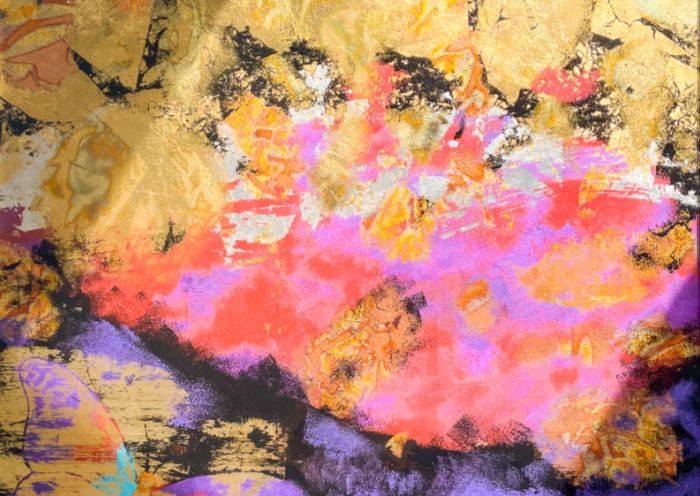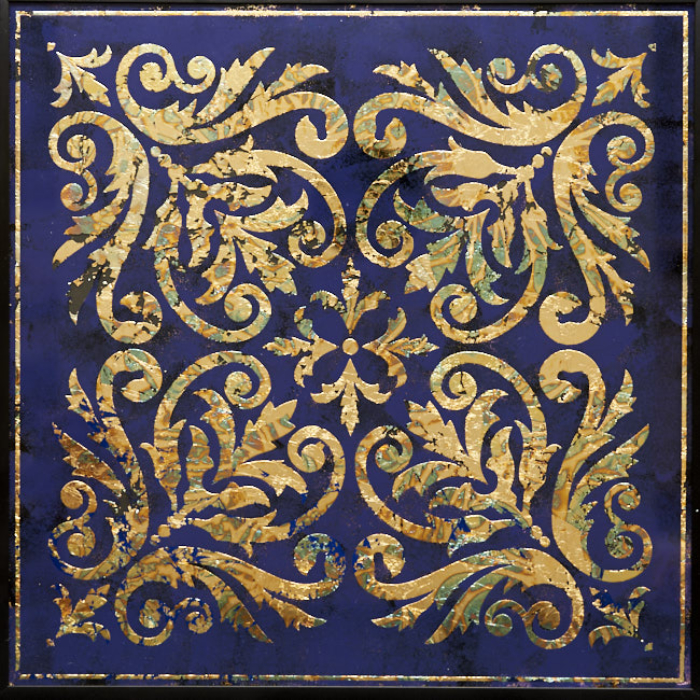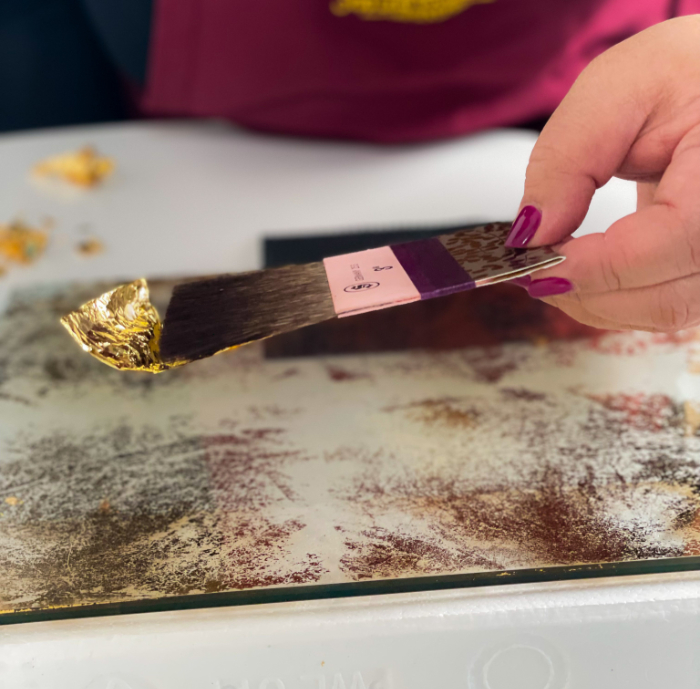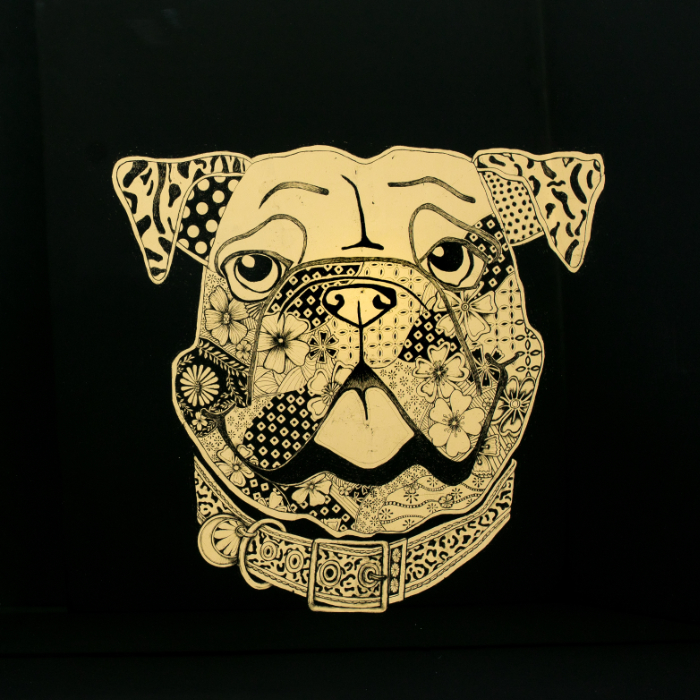
A heart of gold
Marybeth Ting loves nothing more than sharing her skills in glass gilding. She pushes the boundaries of the traditional verre églomisé technique by combining it with different materials. Linda Banks finds out more.
You have a background in interior design. What led you to start working with glass?
I have always been fascinated by gilded objects and how they enhance interior spaces. Around 2006, I came across verre églomisé online through an organisation that promotes gilded arts called The Society of Gilders. I fell in love with the art form as soon as I attended my first gilding workshop. The rich historical background and the labour-intensive process of beating gold into delicate pieces of gold leaf shows the craftsmanship of making the material alone. Additionally, creating a physical product with my time, body and energy is fulfilling.

What decorative glass techniques have you used and which do you prefer?
My specialisation is verre églomisé using genuine gold leaf. Through the years, I have also expanded my techniques to use non-precious metal leaf, patination, and inlay using mother of pearl. I integrate more techniques to create a unique design. If I had to choose, I prefer to work with genuine gold leaf, since the result is more stunning and timeless. This may be challenging to handle compared to non-precious leaf, but most etching techniques work best with the genuine gold leaf as they result in more intricate detail. For me, it is important to work with the highest quality materials and I love the delicate handling involved in making a single work. To the untrained eye, it’s difficult to tell the difference, but as an artist, even though nobody may see it, you will know, and that will show your dedication to making something great.

What is your creative approach? Do you draw your ideas out or dive straight in with the materials?
I visualise and sketch out the design concept, then I make my notes on specification and materials. verre églomisé is done in reverse order, from foreground to background, so I plan out the complete process before I start gilding. Although planning is important, the plans may change. Sometimes I find more clarity to my design vision or find a more interesting perspective to take, so I may make adjustments to its execution as needed.
You have built upon your traditional gilding methods, exploring patination and using mother of pearl inlay. What drives you to push the boundaries of what is possible?
As an artist, I am constantly challenged by the limitless design possibilities. I want to explore more materials and apply different techniques to produce a unique twist to this very traditional craft. Also, it helps me add more nuance to my design by incorporating materials and techniques that are often not used together in a single project.

What is your favourite tool or piece of equipment and why?
The essential tools for gilding, such as the gilder’s tip, knife, pad, and brushes are all stored in my gilding kit. Opening my kit excites me because it signals the beginning of my gilding process. It never gets old.

Do you have a favourite piece you have made? Why is it your favourite?
Bruno, the gilded bulldog, is my favourite. I was on the phone with my brother and he was talking about his adorable bulldog named Bruno. I wanted to create something unusual in the world of verre églomisé, so I decided to make a project centred around my brother’s dog. When I was drafting the sketch, there was a pile of Chigoyami and metallic Kinkaku Japanese papers sitting on my desk. I had this creative instinct to integrate that idea into my draft, so I was inspired to use these Japanese patterns on Bruno. It felt ambitious, since it was my first big project, but it helped me grow by utilising all the techniques I knew at the time and learning more nuance about my craft. I consider this project to be a significant milestone in my verre églomisé journey.

Where do you show and sell your work?
You can visit my website www.marybethting.com to see my work, or my Instagram @marybeth.ting shows more projects I’m working on day-to-day.
You are an instructor with the Society of Gilders and have produced online courses to teach Verre églomisé techniques. Why is it important to share these skills?
When I began my journey in mastering verre églomisé, there weren’t many learning opportunities. It felt like it was on the brink of extinction, since there were only a handful of people that taught, and even those who were capable of teaching no longer wanted to teach to keep the exclusivity of the art form.
After years of attending workshops taught by a select few, and experimenting on my own, I gained the confidence to start teaching the art form myself. As a certified instructor of the Society of Gilders, I wanted to give people the opportunity to learn verre églomisé and appreciate it as much as I did when I was exposed to it for the first time. But, most importantly, by offering these classes online, I can reach people around the world who aren’t able to travel for in-person workshops.
This year, the Society of Gilders is hosting an in-person conference where I will be among the instructors to teach verre églomisé and other forms of gilding, on frames, exteriors, statues and more. If you’re interested to learn more about gilding, I recommend visiting their website at https://societyofgilders.org/.
Who or what inspires you?
Aside from the gilded works of Gustav Klimt, some of my favourite artists are Yayoi Kusama and Takashi Murakami. I enjoy their playful creations and the fact that they are unapologetic about their colourful personalities. I also take inspiration from my own stories and experiences that trace back to my early childhood. I channel my emotions into abstract and intuitive designs in my projects. Each project is a collection of my experiences that resonate with me.
Did the coronavirus impact your practice and, if so, how did you adapt?
The coronavirus pandemic caused delays in shipping artwork and the cancellation of in-person classes that I wanted to teach. Despite these obstacles, I adapted by teaching my gilding class online, gaining a more global reach. Also, by staying at home due to COVID-19 restrictions, I had more time to sit down and experiment with new techniques to incorporate into future verre églomisé projects.

About the artist
Marybeth Ting discovered the art of verre églomisé when she moved to Toronto, Canada, in 2005. This art form is embedded in rich history dating back to the 18th century, employing various metals and the iconic gold leaf on glass to produce a lustrous finish.
A traditional art complemented with contemporary techniques, Marybeth has elevated the art form inspired by nature motifs, natural patterns and textures, along with artistic influence dating back to her early childhood. Her artistry continues to evolve exploring skills in patination and using mother of pearl inlay on glass.
Marybeth is a certified instructor of verre églomisé under the Society of Gilders, a professional member of the American Society of Interior Designers (ASID) New York-Metro and the Association of Registered Interior Designers of Ontario (ARIDO).
She has worked with clients on commissioned pieces ranging from glass paintings to tabletops and wall panels. Her work is exhibited and collected internationally.
Main feature image: Detail of ‘Edna’, a very personal piece dedicated to Marybeth’s mother who is suffering from dementia. It features 22k gold leaf and various metals, with strong bright colours that convey her intense, conflicting emotions of love and sadness.